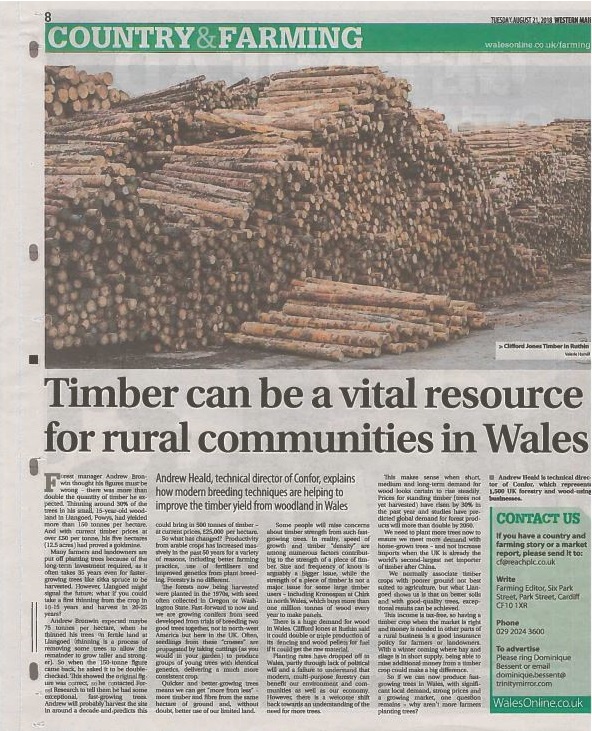Super-sitka growing super-fast
22 August 2018
Fast-growing Sitka Spruce on a small site in mid-Wales could lead to a re-think on how quickly forests can be harvested.
Andrew Heald, Confor’s Technical Director, says the “exceptional” trees in Powys have confounded the experience of foresters.
Forest manager Andrew Bronwin, Confor’s co-chair in Wales, thought his figures must be wrong when the site was thinned last year.
He was taking out around 30 per cent of the trees from his 5-hectare, 15-year-old woodland in Llangoed, and expected around 75 tonnes per hectare. In fact, the thinning yielded more than 150 tonnes per hectare – and with current prices at over £50 per tonne, the site had proved a gold mine.
“I couldn’t believe the numbers and asked for them to be double-checked,” said Mr Bronwin. “When they proved to be correct, I contacted Forest Research to tell them I had some exceptional, fast-growing trees.”
Mr Bronwin thinks he could be harvesting the whole site within a decade – just 25 years after planting – and could bring in 500 tonnes of timber per hectare.
Andrew Heald said the Llangoed experience was an exciting breakthrough for forestry.
“Many farmers and landowners are put off planting trees because of the long-term investment required, as it typically takes 35 years for faster-growing trees like Sitka Spruce to be harvested. However, Llangoed might signal the future; what if you could take a first thinning from the crop in 10-15 years and harvest in 20-25 years?”
Mr Heald said productivity in forestry had improved dramatically, with conifers being grown from seed developed from trials of breeding two good trees together. Seedlings from these ‘crosses’ are propagated by taking cuttings to produce a much more consistent crop of trees.
“Quicker and better-growing trees means we can get more from less - more timber and fibre from the same hectare of ground and without doubt, better use of our limited land,” Mr Heald said. “We normally associate timber crops with poorer ground not best suited to agriculture, but what Llangoed shows us is that on better soils and with good quality trees, exceptional results can be achieved.”
He acknowledged that some people would be concerned about timber strength from such fast-growing trees, but added: “Speed of growth and density are just two factors of many contributing to the strength of a piece of timber. Size and frequency of knots is arguably a bigger issue, while the strength of a piece of timber is not a major issue for some large timber users.”
Mr Heald said there was enormous demand for timber in Wales – some producers, including Clifford Jones in Ruthin, have said that could increase production significantly if they could get more timber.
He added: “Planting rates have dropped off in Wales, but we are starting to see politicians including Lesley Griffiths and Hannah Blythyn, develop a good understanding of how modern, multi-purpose forestry can benefit our environment and communities as well as our economy.
“A step change in tree planting makes sense when short, medium and long-term demand for wood looks certain to rise steadily – and prices for standing timber (trees not yet harvested) are at a modern-day high. We need to plant more trees now to ensure we meet more demand with home-grown trees – and not increase imports when the UK is already the world’s second-largest net importer of timber after China.”
Mr Heald said forestry was a great opportunity to diversify, especially for farmers in the uplands: “Having a timber crop to be harvested when the market is right and money is needed in other parts of a rural business is a good insurance policy for farmers or landowners. With a winter coming where hay and silage is in short supply, being able to raise additional money from a timber crop could make a big difference.
“So if we can now produce fast-growing trees in Wales, with significant local demand, strong prices and a growing market, just one question remains: why aren’t more farmers in Wales planting trees?”
Read the article in the Western Mail here.

